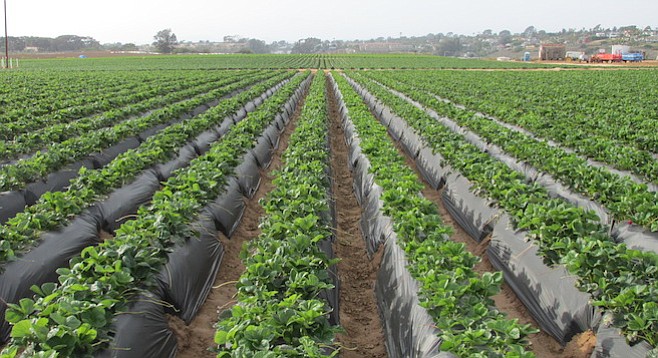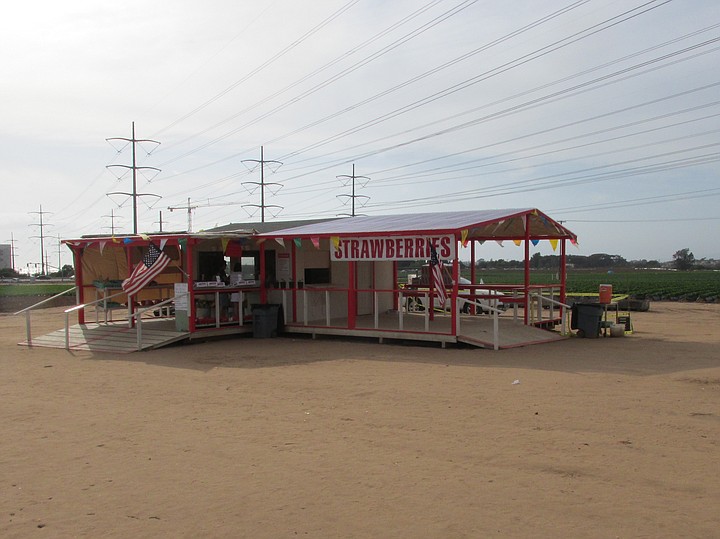Here's something you might be interested in.
Get Involved
 Facebook
Facebook
 X
X
 Instagram
Instagram
 TikTok
TikTok
 Youtube
Youtube

The future developer of the 203-acre California Strawberry Farm, east of I-5 on Cannon Road, may be trying an end-run around city hall and Carlsbad citizens.
Last month, the owners of the land at the pick-your-own strawberry fields announced plans to develop some of the acreage just east of I-5 on Cannon Road, into an upscale shopping center.

The property owner, Caruso Affiliated, says only 27 acres closest to the freeway will be used. The remainder will stay in strawberry production, continuing with the current third-generation strawberry-farming family. Plans also call for an amphitheater and nature trails overlooking the south shore of Agua Hedionda Lagoon.
On May 19, the Carlsbad City Council was advised that Caruso Affiliated would try to place the development directly to the voters through the initiative process. This basically eliminates the city’s planning and public-hearing phases and reduces the developer’s costly regulatory hoops (although the developer reportedly said he will pay for the cost of bringing the issue to the voters).
Some say the initiative tactic used by big developers is a ploy to sway a generally uninformed electorate; or, in some cases, hoodwink them with slick or misleading campaigns. Additionally, councilmembers usually get a little nervous when angry mobs of voters show up at public hearings, usually opposed to large-scale development projects. Thus, councilmembers are more likely to follow public sentiment and vote against a project.
Most recently, talk of an initiative campaign convinced the City of Carson to offer land for the proposed Chargers/Raiders stadium. Locally, other initiative attempts have either stalled, reduced, or stopped projects in the past decade: a second Walmart in San Marcos, a ban on big-box retailers in San Diego, developing the remaining Ecke poinsettia farmland in Encinitas, One Paseo commercial development in Carmel Valley, and in last November’s election, the proposed 430-home development on the old Escondido Country Club.
As reported in the Coast News, the developer has lined up big guns for the signature-gathering drive: former planning commissioner Bill Dominquez, Agua Hedionda Lagoon Foundation’s Maureen Simons, and former Carlsbad Chamber of Commerce CEO Carlton Lund.
The group will formalize the ballot measure’s name soon. They have the next six months to collect petition signatures of 10 percent of registered voters in Carlsbad in order to qualify for the June 2016 ballot.
But Carlsbad residents should have seen this coming ten years ago, when voters passed another initiative, Proposition D. The measure set aside as permanent open space 300 acres along Cannon Road, which included some of the strawberry fields and the hills above the lagoon. Some Carlsbad activists say voters were duped, thinking open space was a good thing, but not realizing the rest of land could then be rezoned as commercial.
At its May 19 meeting, the city council approved city staff beginning its review of the project’s already submitted environmental impact report, which is said to be over 4000 pages.
As a local resident said sarcastically while paying for his strawberries at the little stand in the middle of the fields, “Just what we need, another shopping center.”


The future developer of the 203-acre California Strawberry Farm, east of I-5 on Cannon Road, may be trying an end-run around city hall and Carlsbad citizens.
Last month, the owners of the land at the pick-your-own strawberry fields announced plans to develop some of the acreage just east of I-5 on Cannon Road, into an upscale shopping center.

The property owner, Caruso Affiliated, says only 27 acres closest to the freeway will be used. The remainder will stay in strawberry production, continuing with the current third-generation strawberry-farming family. Plans also call for an amphitheater and nature trails overlooking the south shore of Agua Hedionda Lagoon.
On May 19, the Carlsbad City Council was advised that Caruso Affiliated would try to place the development directly to the voters through the initiative process. This basically eliminates the city’s planning and public-hearing phases and reduces the developer’s costly regulatory hoops (although the developer reportedly said he will pay for the cost of bringing the issue to the voters).
Some say the initiative tactic used by big developers is a ploy to sway a generally uninformed electorate; or, in some cases, hoodwink them with slick or misleading campaigns. Additionally, councilmembers usually get a little nervous when angry mobs of voters show up at public hearings, usually opposed to large-scale development projects. Thus, councilmembers are more likely to follow public sentiment and vote against a project.
Most recently, talk of an initiative campaign convinced the City of Carson to offer land for the proposed Chargers/Raiders stadium. Locally, other initiative attempts have either stalled, reduced, or stopped projects in the past decade: a second Walmart in San Marcos, a ban on big-box retailers in San Diego, developing the remaining Ecke poinsettia farmland in Encinitas, One Paseo commercial development in Carmel Valley, and in last November’s election, the proposed 430-home development on the old Escondido Country Club.
As reported in the Coast News, the developer has lined up big guns for the signature-gathering drive: former planning commissioner Bill Dominquez, Agua Hedionda Lagoon Foundation’s Maureen Simons, and former Carlsbad Chamber of Commerce CEO Carlton Lund.
The group will formalize the ballot measure’s name soon. They have the next six months to collect petition signatures of 10 percent of registered voters in Carlsbad in order to qualify for the June 2016 ballot.
But Carlsbad residents should have seen this coming ten years ago, when voters passed another initiative, Proposition D. The measure set aside as permanent open space 300 acres along Cannon Road, which included some of the strawberry fields and the hills above the lagoon. Some Carlsbad activists say voters were duped, thinking open space was a good thing, but not realizing the rest of land could then be rezoned as commercial.
At its May 19 meeting, the city council approved city staff beginning its review of the project’s already submitted environmental impact report, which is said to be over 4000 pages.
As a local resident said sarcastically while paying for his strawberries at the little stand in the middle of the fields, “Just what we need, another shopping center.”
Comments